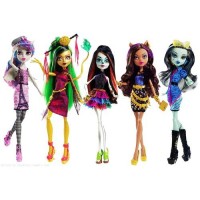The Boston Globe just published an interview with Michelle Ann Abate, a professor at Ohio State University who has just published a book about the tradition of murder and violence in children’s literature (a really interesting take on the “scaring the children” theme). I’m not sure if it’s because of the way the interviewer edited the interview for publication, but for some reason both he and she come across as seeming surprised that there is a tradition of violence in children’s literature, and she’s actually quoted as saying that “the story of violence and books for young readers hasn’t been told before”.
I have to say that I am surprised at the surprise that there is a tradition of violence in children’s literature. It’s a frequent reason that books are banned (although racism, explicit sexual situations, and profanity currently top that). Going back in history, even after you progress past Grimm’s fairy tales, there’s no lack of violence and death. Andersen’s tales often end with death. “The Little Match Girl”, for instance, freezes to death on the street.

Struwwelpeter, by Heinrich Hoffman, is a classic children’s book, with lovely illustrations. Here’s one for a story about a girl with matches who burns to death!
And let’s not forget the Gashlycrumb Tinies. Poor Kate! Childhood used to be a much different creature than it is today, a point that Abate does make, and attitudes toward parenting tended toward the didactic and scaring kids into behaving. It is interesting to note, though, that Hoffman wrote the book to entertain his young child, and in spite of the terrifying stories and illustrations, there are a lot of adults who remember it as being funny when they were kids. There’s a darkness inside children that a lot of grownups don’t want to admit is there.

“K is for Kate who was struck with an axe”
Moving on to more recent times, we have the parents of the kids in Julian Thompson’s The Grounding of Group 6, who send their kids to a school that guarantees they’ll be permanently lost in the woods; the viciousness of the children in William Sleator’s House of Stairs; the matter-of-fact euthanasia of children and the elderly in Lois Lowry’s The Giver; the government approved murders of “extra” children in Margaret Peterson Haddix’s Among the Hidden; the chilling account of the Holocaust in The Devil’s Arithmetic; the supernatural terrors from Alvin Schwartz’s Scary Stories to Tell in the Dark; the death of Cedric Diggory in Harry Potter and the Goblet of Fire. Death, and especially murder, can be scary in books, but nowhere near as scary as daily life. Processing the assassination of Martin Luther King, Jr. is a lot more difficult for my kids than processing The Tailypo.
Many people– librarians, critics, parents, academics– have considered the story of violence in children’s books. Nearly every year there’s at least one article about how children’s literature has gotten too dark. I would say that it’s an aspect that people either choose to avoid (it’s not difficult to avoid children’s books containing murders) or take for granted. When something like The Hunger Games or Goosebumps becomes massively popular, violence in children’s books comes into the spotlight, but even when it’s not in the spotlight, there are people who notice it, study it, and write about it. I think as transmedia platforms become more popular we’ll see more of this come to light, as books and visual media connect in more ways than ever, and this is definitely a topic worth paying attention to… but if the study of violence in children’s literature hasn’t been noticed before, it’s only because people didn’t want to see what was really there.
 So, one of the things that we talk about at MonsterLibrarian is the value of using media tie-ins and cross-platform media to get people involved in reading horror fiction. Given the way our world is evolving today, the natural targets for marketers are kids. I watch kids who do a great job integrating existing media characters and stories into completely different scenarios (the Monster Kid’s many stories about the classic mystery solving team of Detective Baby Godzilla and Scooby Doo come to mind) but, frankly, Godzilla and Scooby Doo are small potatoes when it comes to marketing to kids today.
So, one of the things that we talk about at MonsterLibrarian is the value of using media tie-ins and cross-platform media to get people involved in reading horror fiction. Given the way our world is evolving today, the natural targets for marketers are kids. I watch kids who do a great job integrating existing media characters and stories into completely different scenarios (the Monster Kid’s many stories about the classic mystery solving team of Detective Baby Godzilla and Scooby Doo come to mind) but, frankly, Godzilla and Scooby Doo are small potatoes when it comes to marketing to kids today.



Follow Us!